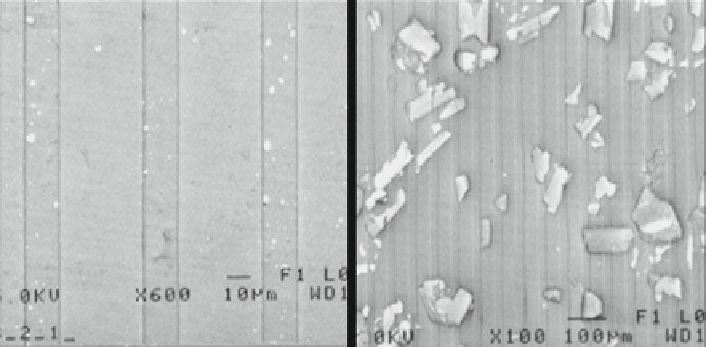Biomedical Engineering Reference
In-Depth Information
Fig. 10
The image (SEM) on the
left
shows a membrane that has had nanopores incorporated into
the PCL. The image (SEM) on the
right
shows a membrane that has had pores created through
sodium bicarbonate leaching. The membrane on the
left
shows an intact pattern while the mem-
brane on the
right
shows considerable disruption of the pattern
create a network of interconnected pores that allow diffusion through the membrane
but does not disrupt the micropattern on the surface. Cells still react to the micro-
topography of the scaffold and align with the parallel channels. By comparison,
when porous PLGA membranes were created using sodium bicarbonate crystals as
the leachant, a disrupted surface pattern was generated on which the SMCs were no
longer able to align (Fig.
10
).
Micropatterning of scaffolds has been an important technique for tissue engineers
to create controlled environments for cells in vitro in order to recreate their in vivo
structure and function. With the new techniques presented here for creating three-
dimensional tissue constructs, it is possible to control aspects such as porosity of the
material without disrupting the physical cues with which the cells need to interact.
Moving to the nanoscale to create pores now allows scientists and engineers to gain
control over another size scale in the hierarchy of engineered tissues.
5
Nanoporous Capsules for Immunoprotection
of Insulin Producing Cells
Controlling the nanoscale features of materials is not only important for creating
surfaces for cells to grow on. Working at the nanometer size range means we are
working at the size of individual molecules of importance to life. If we can control
individual biomolecules through the intelligent engineering of materials, it may be
possible to treat diseases in a manner not currently possible.
For a person suffering from Type I diabetes, the most widely used treatment is
the daily injection of insulin. The use of injectable insulin has many problems for
the patient including compliance, discomfort, inconvenience, and the fact that self

